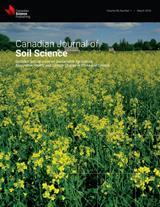Incorporation of salvaged peat in soil cover designs for oil sands mine reclamation is a common practice. However, current peat salvage practices do not differentiate between peatland types or the botanical composition of peat. In this study, we characterized the botanical composition of natural peat and coversoil on reclaimed sites and examined the influence of botanical composition on the physicochemical characteristics of reclaimed coversoil. Peat samples were collected from 15 natural peatlands (bog, poor fen, and rich fen) and peat coversoils were sampled from six reclaimed sites in the Athabasca oils sands region. The botanical compositions (Sphagnum, wood Sphagnum, woody, and woody/moss herbaceous) of all samples were determined. We found that natural peatland types had different physicochemical properties, primarily driven by Sphagnum-dominated samples with a high carbon:nitrogen (C:N) ratio and low total exchange capacity (TEC) when compared with samples dominated by more woody/moss herbaceous material. Similarly, we found that coversoil with Sphagnum-dominated peat compared with woody/moss herbaceous peat had lower TEC, pH, and total nitrogen values and higher C:N ratios (∼40 vs. 20 for Sphagnum and woody/moss herbaceous, respectively). Our results indicate that physicochemical properties driven by botanical composition remain in coversoil 5 yr after placement.
How to translate text using browser tools
30 May 2019
Strong legacy effect of peat composition on physicochemical properties of reclamation coversoil
Teri Calver,
Marty Yarmuch,
Alexandra J. Conway,
Katherine Stewart
ACCESS THE FULL ARTICLE
It is not available for individual sale.
This article is only available to subscribers.
It is not available for individual sale.
It is not available for individual sale.
Athabasca oil sands
bog
fen
peatland
reclamation
surface mining





